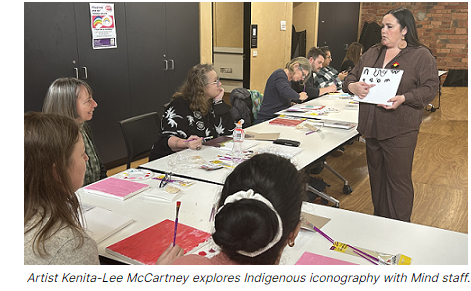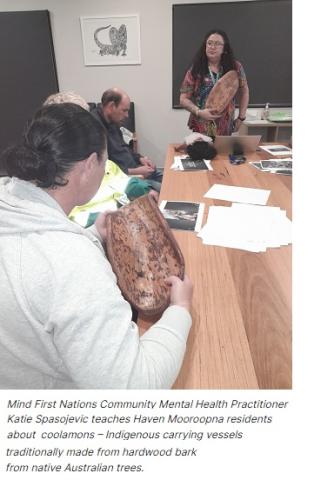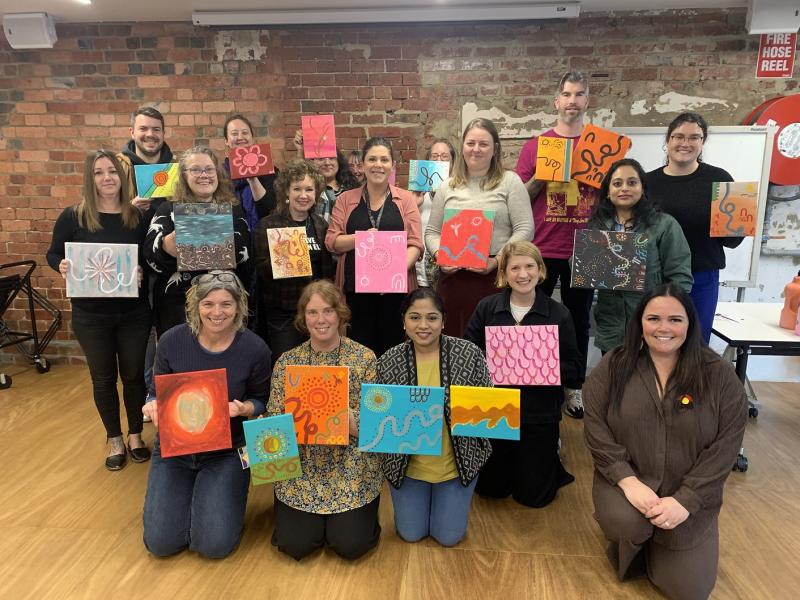Practicing and learning the art of storytelling was a theme across NAIDOC week celebrations held at Mind offices and services throughout Australia this year.
NAIDOC (7-14 July) is an opportunity for all Australians to learn about First Nations culture, histories, and participate in celebrations of the oldest, continuous living cultures on earth.
“NAIDOC is a big week for us; we call it Blak Christmas and I encourage everyone to get as involved as possible to learn about and celebrate our culture,” artist Kenita-Lee McCartney explained to a painting workshop for Mind staff held in Burnley (Victoria).
Kenita-Lee, a proud Wemba Wemba, Wiradjuri, Wotjiboluk, Nari Nari, and Boon Wurrung woman, shared some of her heritage and stories through her artwork, and taught participants about Indigenous iconography – a way of transferring knowledge and stories through symbols.

These symbols represented people, native animal tracks, journey lines, our ancestors looking down at us and the sun. Kenita-Lee explained that iconography is an important part of First Nations’ art and as a means of communicating across generations.
Warren Roberts from YARN Australia also discussed with Mind staff what it means to share your story, and offered advice on how this can be achieved with meaning and purpose.
YARN is a social enterprise focused on creating relationships and intentional connections through storytelling between all Australians in the hope of achieving unity.
Warren, a proud Thunghutti and Bundjalung man, explained that storytelling has the ability to deepen our connections with friends, family or the people we support and it’s important to practice the art of storytelling, sharing and listening with purpose.
“We’re the ones who have to create the places and spaces to share those stories, but we have to be intentional about it. It can’t be through an event or just because it’s NAIDOC,” he said.
“We (First Nations people) have been practicing this practice for a long time, but we want to inspire all Australians to do it as well. Then we can meet in the middle and we can share with each other, and continue to learn from one another.”
At Mind’s housing with support residence, Haven Mooroopna (Victoria) staff and residents learnt about tree scarring and coolamons – an Indigenous carrying vessel traditionally used to carry water, fruit, nuts and cradle babies.
Katie Spasojevic – a First Nations Community Mental Health Practitioner at Haven Mooroopna – explained that coolamons are made from hardwood bark from native Australian trees. The process of making coolamons causes scarring on trees, which carries significant historical importance for First Nations people. Scarred trees can tell us where First Nations people used to live and they are significantly easier to find than many other archaeological sites.

Katie, a proud Yorta Yorta woman, said learning about coolamons and scarred trees was enriching for her personally and she hoped sharing these lessons and stories would help First Nations residents at Haven Mooroopna strengthen their connection to culture.
“I want to be able to share the knowledge that I’ve learnt, and pass it on to Hope, Billy and other Indigenous people.
It wasn’t passed down through my Elders, but I researched it myself later on in life, which helped me understand my ancestors and my culture.
I’ve watched some fellas make it [a coolamon] and now I’m making my own – I want to pass that experience and knowledge on and help others learn about their heritage too,” she said.
Opportunities to learn about First Nations histories, and celebrate the oldest living culture in the world, are so valuable. We thank everyone who helped us celebrate NAIDOC for sharing their culture, wisdom and stories with us.
If you would like more information about Mind services near you, please contact us via Mind Connect or phone: 1300 286 463.
